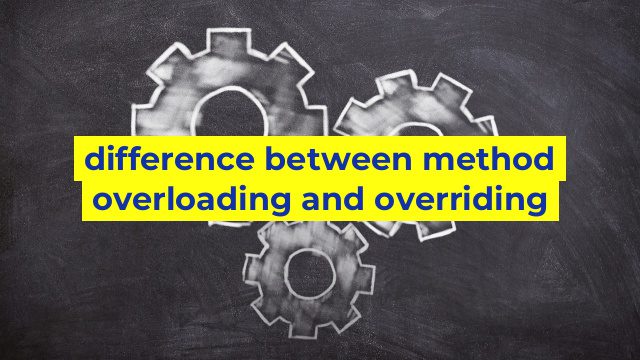The Key Differences between Method Overloading and Overriding
In Object-Oriented Programming (OOP), methods form the building blocks of a program. They are procedures or functions that define how different objects should behave. As you create methods in OOP, you might come across two essential concepts that are often confused – method overloading and overriding. Although both concepts deal with methods, they differ in crucial ways. Here is a closer look at the difference between method overloading and overriding:
Method overloading
Method overloading is an OOP technique that allows you to define multiple methods with the same name within a class. The difference between the methods is in their parameters. In other words, methods vary, depending on the number, data type, or order of their parameters. At compile-time, the compiler determines which method to invoke, depending on the arguments used to call it. Method overloading enables you to reuse a method name, making your code more concise and easier to maintain.
Method overriding
On the other hand, method overriding is a technique that allows a subclass to redefine or modify a method that already exists in its parent class. The overriding method must have a similar signature to the original method, i.e., the same name, return type, and parameter list. When an object of the subclass is created and the overridden method is called, the method of the subclass is invoked, not the superclass. Method overriding is a powerful tool for customizing inherited behaviors, and it enables you to add flexibility and extensibility to your code.
Differences between method overloading and overriding
– Method overloading involves multiple methods with the same name, while overriding involves modifying a method in a subclass that already exists in the superclass.
– In overloading, methods differ in their parameters, while in overriding, the methods have the same name, return type, and parameter list.
– Method overloading is resolved during compile-time, while method overriding is resolved during runtime.
– Method overloading supports polymorphism and facilitates code reuse, while method overriding provides flexibility in customizing inherited behaviors.
To wrap it up, method overloading and overriding are both essential concepts in OOP, but their difference lies in how they handle method names and parameters. Understanding these concepts will help you write more efficient and maintainable code.
Table difference between method overloading and overriding
| Method Overloading | Method Overriding |
|---|---|
| Method overloading enables a class to have multiple methods with the same name but different signatures, i.e., they have different parameter lists. | Method overriding enables a subclass to provide its implementation of a method that is already defined in its superclass. |
| The return type of the overloaded method is not important as it doesn’t affect the method signature. | The return type of the overriding method must be the same as the return type of the method in the superclass. |
| Overloaded methods can have different access modifiers, i.e., public, private, protected or default. | Overriding methods cannot have a more restrictive access modifier than the method it overrides. For example, if a method in the superclass is public, the overriding method in the subclass must also be public. |
| Method overloading is resolved at compile time based on the number, type, and order of the arguments passed to the method. | Method overriding is resolved at runtime and depends on the actual object that is calling the method. |
| Method overloading enhances the readability and maintainability of the code. | Method overriding enables polymorphism, i.e., the ability of objects of different subclasses to be treated as objects of a common superclass. |

